Why Proper Morgue Storage is Critical for Funeral Operations
Morgue-storage- systems are specialized refrigeration units designed to preserve deceased bodies at controlled temperatures between 35-40°F (1.6-4.4°C) while maintaining dignity and supporting funeral home operations. These systems range from single-body cabinets to walk-in cold rooms accommodating up to 30 bodies.
Quick Overview of Morgue Storage Options:
- Cabinet Systems: 1-6 body capacity, front or side-loading
- Walk-in Cold Rooms: 8-30 body capacity with modular panels
- Portable Units: Pop-up systems for temporary or emergency use
- Temperature Range: 35-40°F standard, with freezer options available
- Key Features: Stainless steel construction, digital controls, alarm systems
Modern funeral homes face increasing pressure to provide dignified storage while managing costs and space constraints. With over 232 mortuary cabinet models available from 47 manufacturers, choosing the right morgue-storage- solution requires understanding capacity needs, regulatory requirements, and long-term operational costs.
I'm Mortuary Cooler, a national-level mortuary cooler supplier with extensive experience helping funeral homes select and implement morgue-storage- solutions across the United States. My background includes working with facilities ranging from small funeral homes to large medical examiner offices.
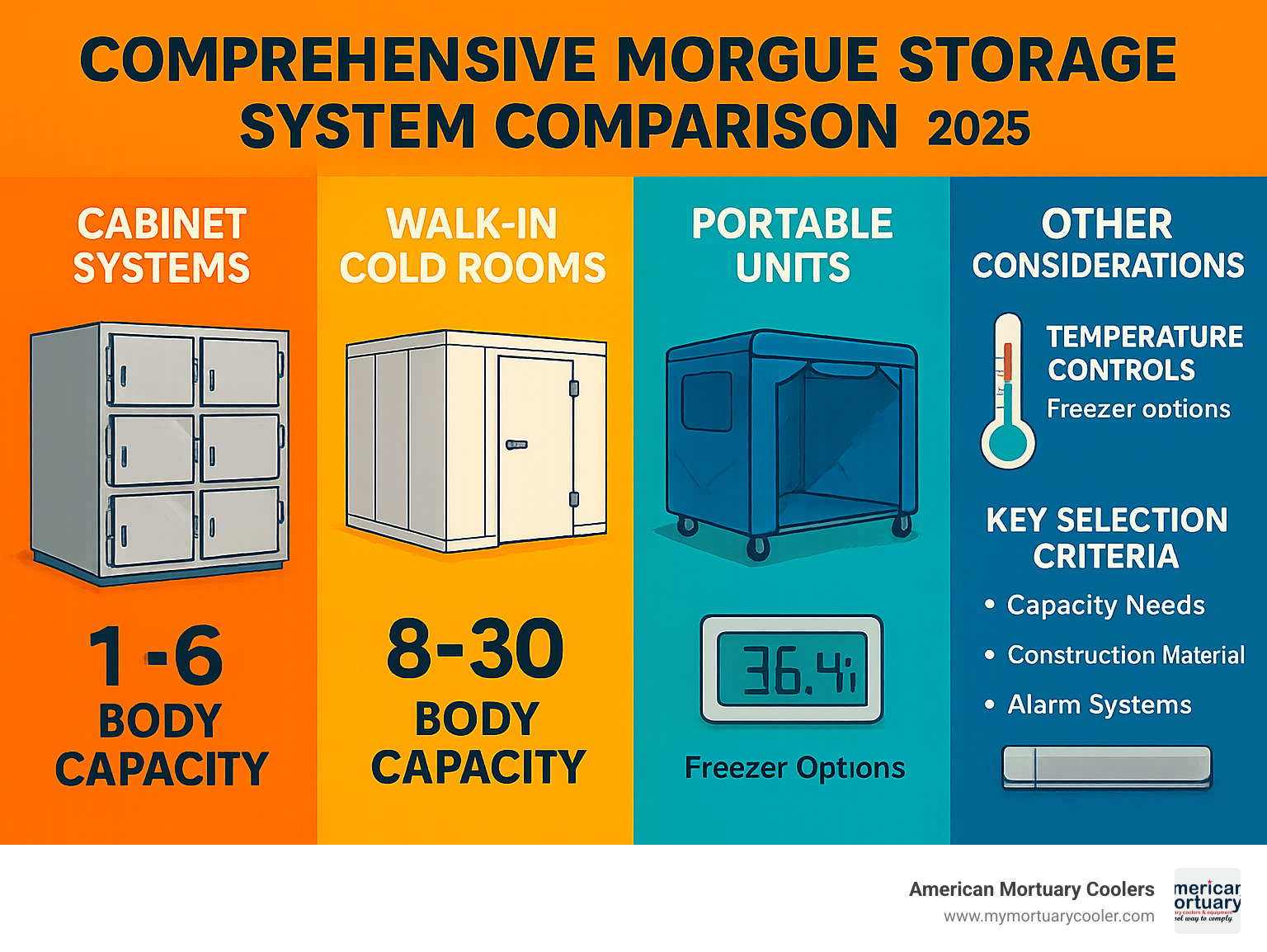
Morgue-storage- glossary:
Morgue-Storage- Fundamentals
Morgue-storage- systems are specialized preservation systems built to maintain the dignity of the deceased while supporting funeral home operations. Bodies need to be kept at a steady 35-40°F (1.6-4.4°C) to slow natural decomposition processes without causing freezing damage.
Modern morgue-storage- features redundant cooling systems with 100% backup capability and automatic switchover if the primary system fails. The insulation uses advanced materials like polyurethane foam with cyclopentane, which is completely CFC-free and environmentally responsible.
Chain-of-custody considerations are built into every quality system with document pockets and clear ID systems for maintaining trust and proper identification.
Types of Morgue-Storage- Systems
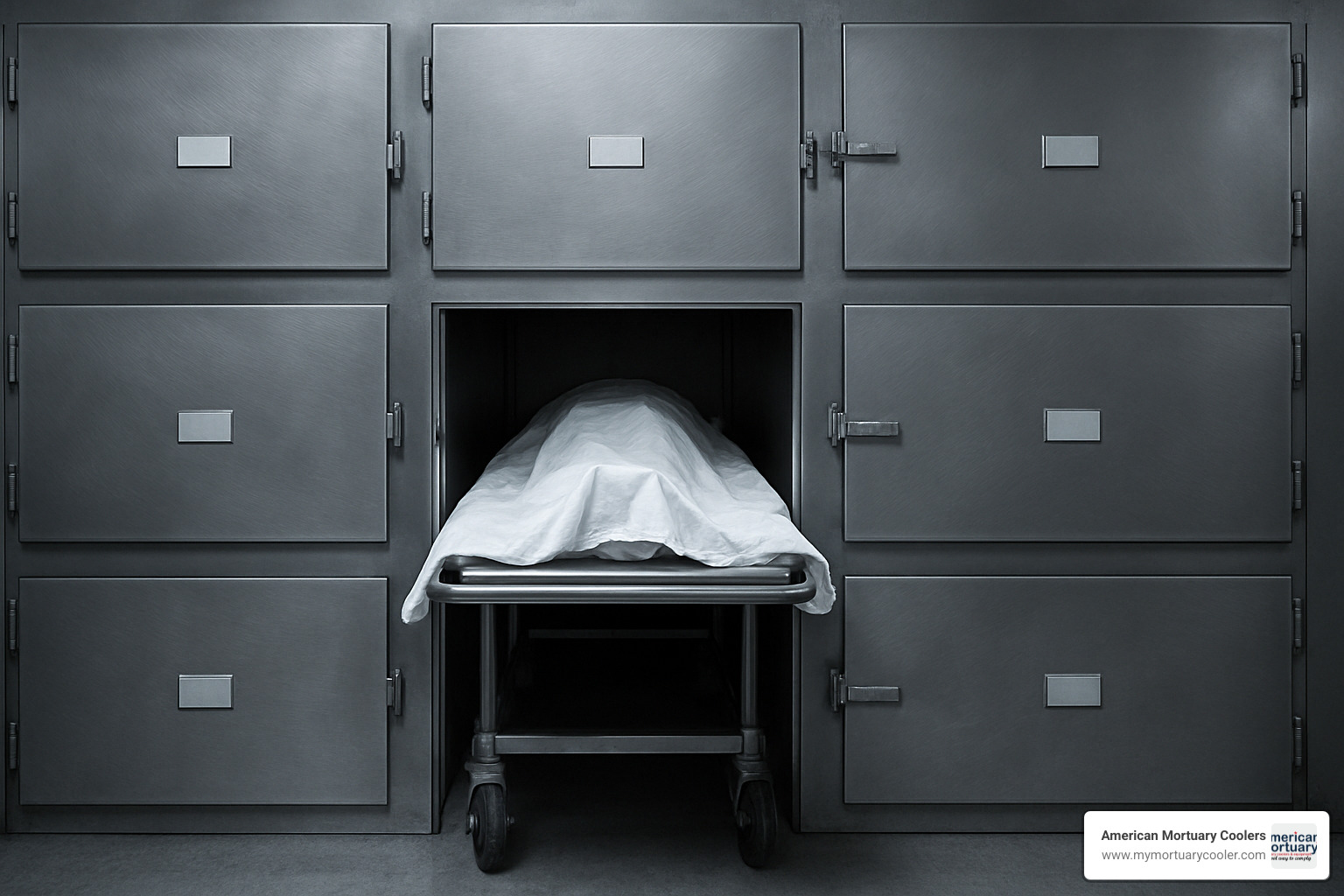
Front-loading cabinets are the workhorses of the industry, with over 200 models available. These units let you load from the front with telescoping trays that slide out smoothly, reducing physical strain on staff.
Side-loading systems work perfectly in tight spaces where front access won't work. With 22 models available, these units are ideal for narrow morgue areas.
Walk-in cold rooms handle 8 to 30 bodies depending on needs. These modular systems use precision panels that can be assembled, taken apart, and relocated if facilities change.
Roll-in units eliminate workflow challenges by allowing entire gurneys or stretchers to wheel directly into storage compartments.
Pop-up portable systems like the AirCool series set up in minutes and maintain proper temperatures even in extreme heat - up to 40°C with the Extreme variant.
Capacity & Footprint Options
Two-body units lead the market with 55 models available. Three-body units follow with 36 models, while single-body units offer 34 options for smaller operations. Multiple-body units provide 28 configurations, scaling up to 15-body capacity.
Bariatric considerations are essential, with modern facilities accommodating individuals up to 256 kg using specialized trays and wider storage compartments with free-standing stainless steel construction.
Space optimization maximizes capacity within existing floor space through cantilever storage racks and multi-tier systems.
Temperature & Environmental Controls

Digital control systems offer remote temperature monitoring, comprehensive alarm systems, automatic data logging for regulatory compliance, and programmable temperature profiles.
Low-ambient kits ensure proper refrigeration operation even when ambient temperatures drop below normal ranges.
Alarm monitoring provides high and low temperature alerts, power failure notifications, door ajar warnings, and compressor failure alerts.
Redundancy systems offer dual cooling with automatic failover, ensuring continuous operation even during equipment failures.
Key Components & Innovations in Modern Morgue Storage
Modern morgue-storage- systems blend advanced materials with cutting-edge technology. Quality units feature stainless steel 304 construction that resists corrosion from harsh cleaning chemicals while maintaining professional appearance.
Polyurethane insulation with cyclopentane provides exceptional thermal efficiency while being completely CFC-free. Most quality units feature 80-100mm thick insulation for consistent temperatures and lower energy bills.
Telescoping slides let trays extend fully outside cabinets, eliminating awkward reaching and lifting. Antimicrobial finishes actively fight bacterial growth, while UV sterilization systems in high-end models create multiple protection layers.
IoT sensors monitor temperature, humidity, door status, and occupancy levels, sending real-time data to prevent problems before they start.
Materials, Hygiene & Odour Control
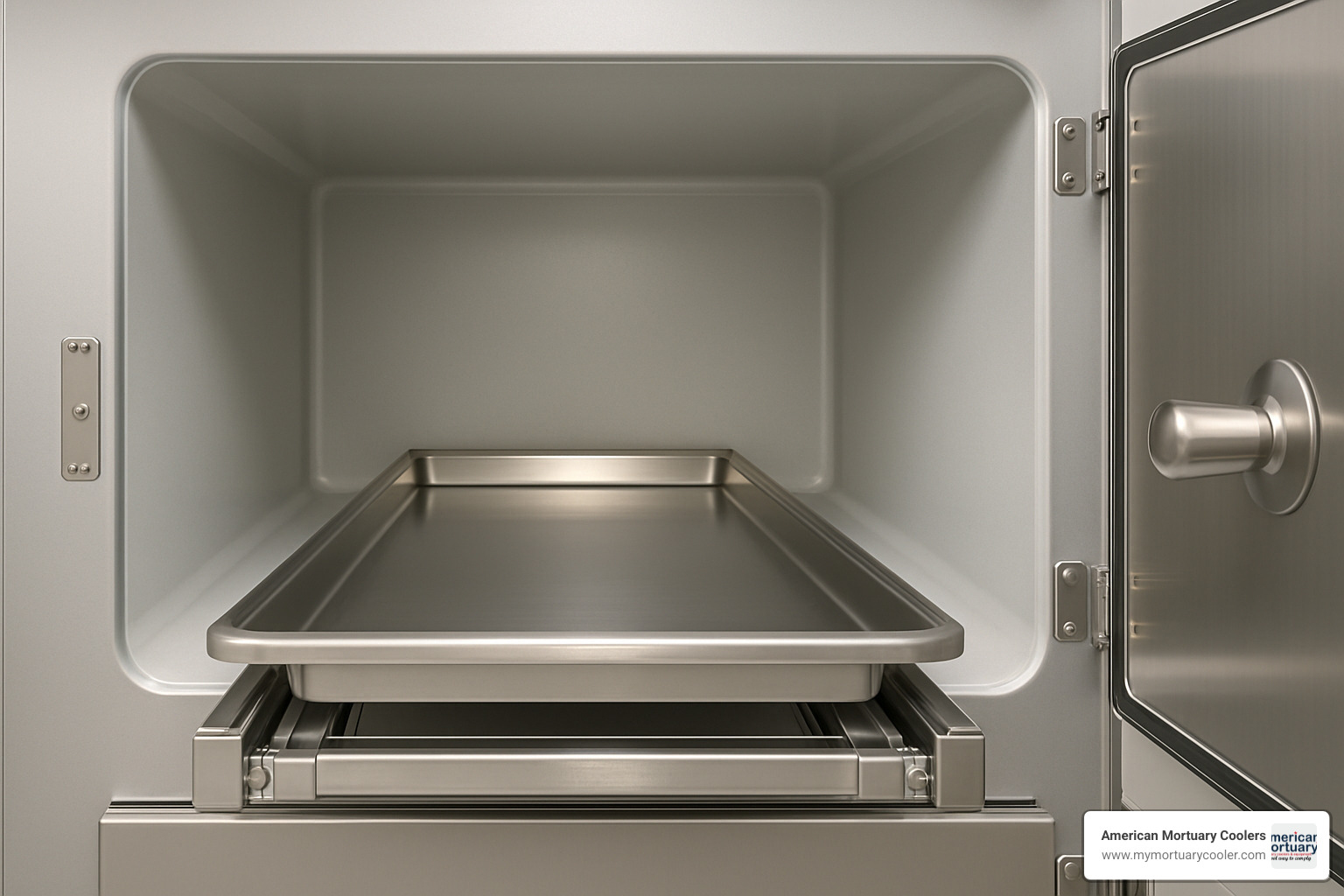
Seamless fiberglass construction eliminates cracks where bacteria hide. Carbon filtration systems actively scrub air inside storage units, removing odors before they escape.
Gasketed doors with magnetic seals create airtight seals preventing odor escape while making doors easy to open. Drain pans and floor drains manage fluids while maintaining sanitary conditions.
All quality systems meet NSF sanitation requirements ensuring every material meets strict hygiene protocols.
Smart Monitoring & Energy Efficiency
Remote telemetry lets managers monitor temperature, door status, and system health from computers or phones. High R-value panels provide superior insulation that reduces energy costs by 30% or more.
Variable-speed compressors adjust operation based on cooling needs, reducing energy consumption and operating more quietly. LED systems with exterior switches provide excellent visibility while consuming minimal energy.
Emerging Tech in Morgue-Storage- Drawers
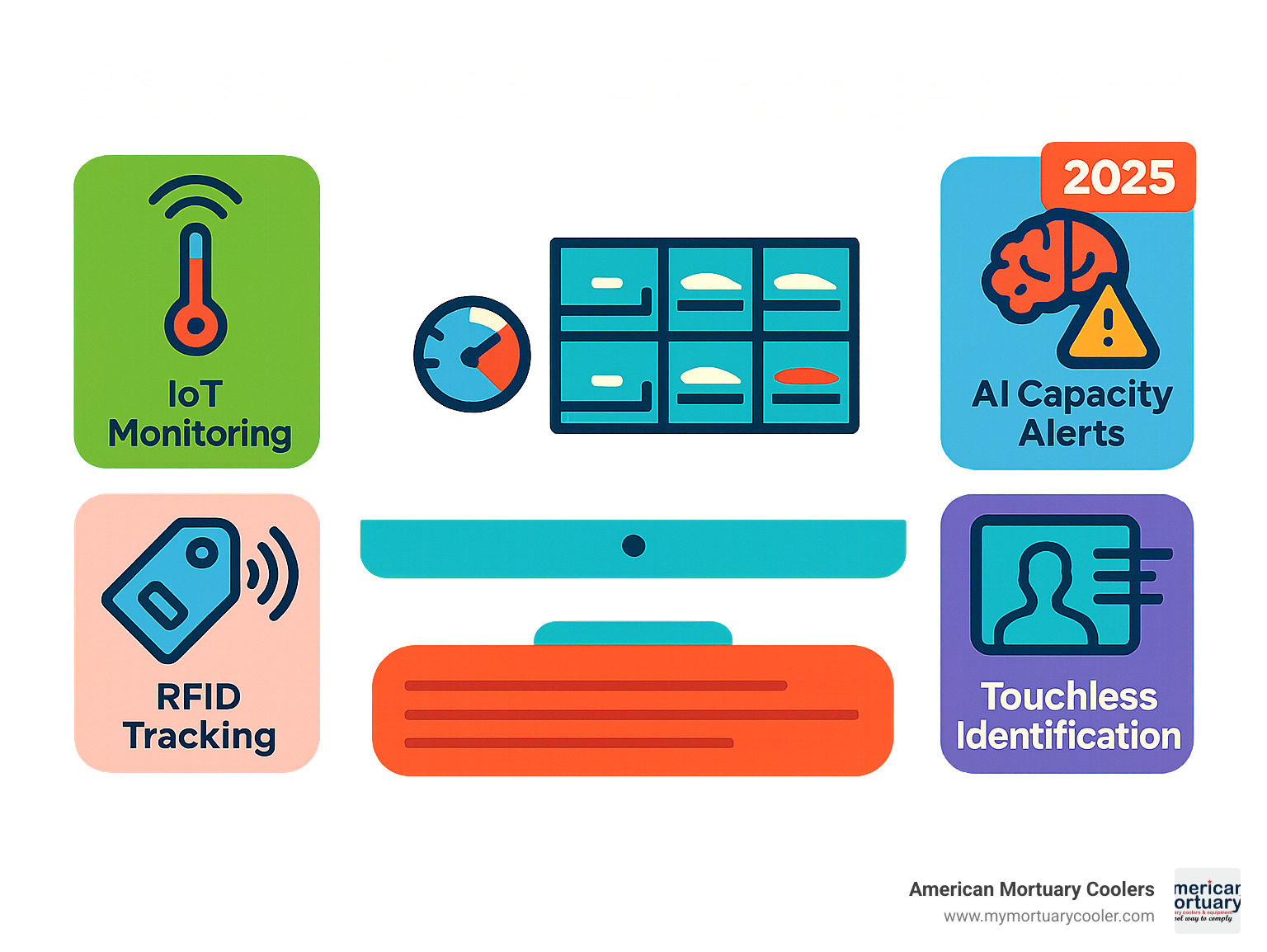
Touchless identification systems use proximity sensors and digital displays to show body information without physical contact, reducing contamination risk.
RFID tagging creates automated chain of custody, logging all activities with timestamps and staff identification, eliminating paperwork errors.
AI capacity alerts analyze usage patterns to predict when additional storage will be needed, learning seasonal patterns and facility-specific factors.
Automated inventory management tracks occupancy across multiple units in real-time, optimizing space utilization and ensuring efficient operations.
Choosing the Right Morgue Storage Solution
Selecting the perfect morgue-storage- system requires understanding your facility's unique needs and finding equipment that serves families with dignity while keeping operations running smoothly.
Budget planning goes beyond initial price to total cost of ownership - including energy, repairs, and eventual replacement. Space challenges require considering staff movement, expansion possibilities, and workflow integration.
Capacity requirements must account for peak demand, not just averages. Regulatory compliance varies by jurisdiction but typically includes temperature monitoring, record keeping, and sanitation standards.
Emergency preparedness through portable units or facility agreements helps handle surge situations during disasters or mass casualty events.
Hospitals vs Funeral Homes vs Forensic Labs
Hospital morgues focus on efficiency and quick turnaround with brief storage before transfer to funeral homes. Systems must integrate seamlessly with autopsy-table- setups.
Funeral homes need longer storage times supporting preparation and viewing activities. Appearance and noise levels become important when families visit facilities.
Forensic laboratories require evidence preservation with strict chain-of-custody protocols and often freezer capabilities for long-term specimen storage.
Mobile & Temporary Solutions
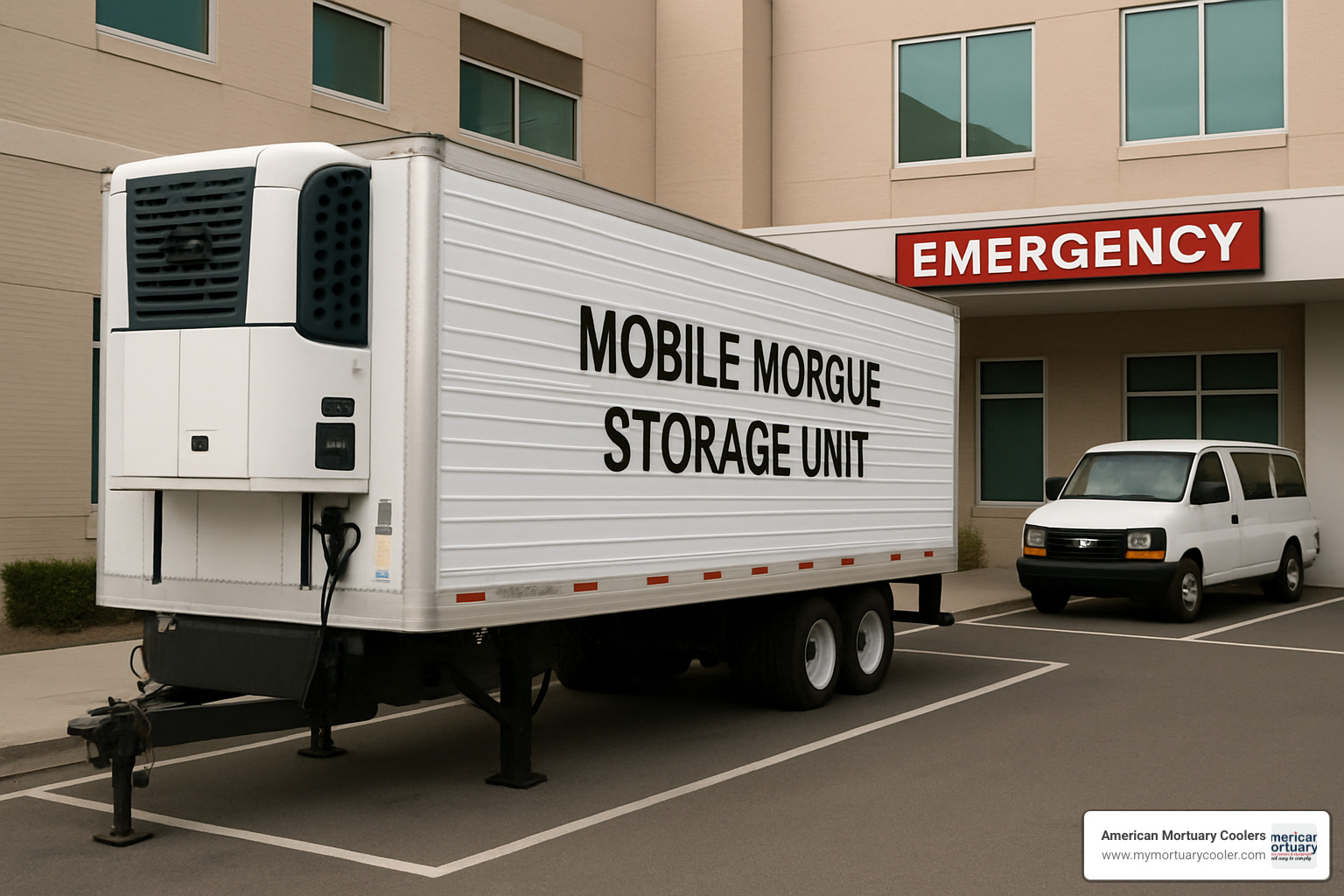
Pop-up AirCool systems transform any space into temporary morgue within minutes, available in sizes from 4 to 24 bodies and maintaining proper temperatures even in 104°F ambient conditions.
Trailer-mounted coolers bring storage capacity wherever needed for facility renovations, disaster response, or serving rural areas. Emergency surge kits help handle unexpected case increases.
FEMA guidelines provide roadmaps for emergency morgue operations, including specifications for temporary storage systems.
Customization & Bariatric Support
Bariatric capabilities have become essential, with systems routinely handling individuals weighing up to 1000 pounds using reinforced trays and specialized lift systems.
Powered lifting assistance eliminates physical strain through battery-powered lifts operating from standard outlets. Flexible configurations allow facilities to adapt storage layouts based on current needs.
| Feature | Standard Units | Bariatric Units |
|---|---|---|
| Tray Width | 23-27 inches | 30+ inches |
| Weight Capacity | 350 pounds | 1000+ pounds |
| Door Size | Standard | Oversized |
| Lift Support | Manual | Powered |
Decision Checklist & ROI
True cost analysis includes installation, energy consumption, maintenance, and replacement costs. Warranty protection should include comprehensive coverage with reasonable response times.
Energy incentives from utilities can offset initial costs significantly. Future flexibility protects investments as needs change over time.
Installation, Maintenance & Compliance
Proper installation and maintenance of morgue-storage- systems ensures reliable operation and regulatory compliance. NSF sanitation standards ensure systems can be properly cleaned and sanitized.
EISA and DOE panel requirements mandate efficiency standards for walk-in coolers, resulting in lower utility bills. Fire-rated insulation and NFPA standards compliance protect facilities and provide family reassurance.
HVAC clearances are essential for reliable operation - proper airflow around equipment prevents overheating and premature failure. Preventive service intervals should become routine to prevent system failures during busy periods.
Regulations & Standards Overview
CDC handling guidelines provide foundations for safe storage practices based on decades of research. State building codes vary significantly, requiring consultation with local authorities early in planning.
OSHA requirements focus on staff safety, including proper lifting techniques and chemical exposure limits. NFPA standards address fire safety comprehensively, covering emergency exits to electrical installations.
Service, Cleaning & Lifecycle Tasks
Planned Preventative Maintenance schedules work best when realistic and manageable. Daily tasks include checking temperature logs and visual inspections. Weekly tasks involve cleaning exterior surfaces and checking door seals.
Swab testing provides objective verification that cleaning procedures work effectively. Condenser cleaning is critical for system performance - dirty condensers work harder, use more energy, and fail sooner.
Gasket replacement prevents temperature loss and energy waste when door seals start failing.
Sustainability & Energy Audits
Insulation upgrades can transform older systems from energy hogs into efficient performers. LED retrofits offer quick returns on investment through reduced energy consumption and heat generation.
Refrigerant transition to environmentally friendly options often improves system performance while reducing environmental impact. LEED credits might be available for high-efficiency systems in facilities pursuing green building certification.
Frequently Asked Questions about Morgue-Storage-
How long can bodies be stored safely?
Bodies can be stored safely in properly maintained morgue-storage- systems for several weeks when kept at consistent 35-40°F temperatures.
Temperature consistency is absolutely critical - even small fluctuations can accelerate decomposition. The condition of the body also affects preservation, as trauma or certain diseases impact tissue preservation.
Preparation makes a big difference - embalmed bodies can be stored much longer than unembalmed ones, sometimes for months when necessary for legal cases or when families need extra time.
Some jurisdictions have legal limits on storage duration, so facilities must stay current with local regulations.
What temperatures are required by law?
Most jurisdictions require temperatures between 35-40°F for refrigerated storage. Most regulations require refrigerated storage within 24-48 hours of death, unless other preservation methods are used.
Documentation is crucial for legal compliance. Facilities typically need continuous temperature monitoring with written logs reviewable during inspections. Modern systems make this easier with digital logging and automated alerts.
Some areas require backup cooling systems to ensure uninterrupted storage capability. Always check with local health department and regulatory authorities for specific requirements.
When should a facility rent versus buy storage?
Renting makes sense for temporary situations like facility renovations or sudden demand from local tragedies. Budget constraints sometimes make renting the only initial option.
Buying becomes better when needs are established and ongoing. If you're consistently using storage capacity month after month, ownership usually provides better value with customization options.
At American Mortuary Coolers, we help facilities analyze their specific situations, volume patterns, and financial considerations to determine the best approach.
Conclusion
Choosing the right morgue-storage- system honors the dignity of those in your care while building efficient, compliant operations. The right storage solution transforms daily operations and provides peace of mind for families during difficult moments.
At American Mortuary Coolers, we've worked with facilities across all 48 contiguous states, learning that each installation requires understanding your specific needs. You need reliable temperature control, durable construction, and a partner who understands this equipment's sacred purpose.
Our custom-built approach means your morgue-storage- system arrives designed specifically for your space, workflow, and community needs. We handle everything from engineering to nationwide delivery.
For detailed guidance on selecting the right system, explore our comprehensive resource: The Definitive Guide to Mortuary Storage Solutions. Our team stands ready to discuss your specific needs and help you invest in a solution that will serve your community faithfully for decades.
When you choose morgue-storage- equipment, you're investing in your ability to serve families with dignity and respect during life's most challenging moments.
















